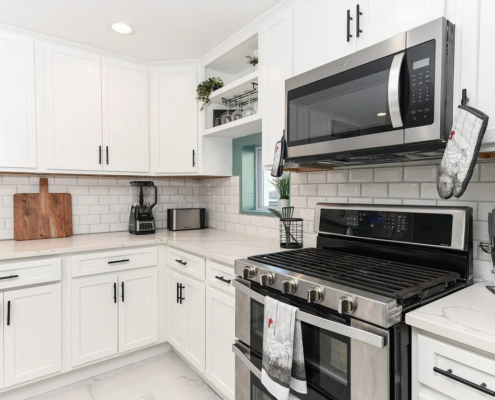Small Appliance Troubleshooting Tips for Beginners
 In today’s fast-paced world, small appliances play a crucial role in making daily tasks easier and more efficient. However, when these handy devices encounter problems, it can disrupt your routine and lead to unnecessary stress.
In today’s fast-paced world, small appliances play a crucial role in making daily tasks easier and more efficient. However, when these handy devices encounter problems, it can disrupt your routine and lead to unnecessary stress.
Understanding basic troubleshooting techniques not only empowers you to handle minor issues on your own but also offers significant savings on repair costs. For those new to DIY repairs, our guide provides simple tips to get your gadgets back in action. And remember, if you ever face more complex issues beyond basic repairs, professional appliance repair can help.
Article Summary:
- Understanding Common Appliance Issues
- Essential Tools for Appliance Troubleshooting
- Tips for Fixing a Non-Responsive Coffee Maker
- Solving Blender Motor Problems
- Microwave Not Heating? Here’s What to Do
- Tackling Toaster Troubles
- Easy Fixes for Vacuum Cleaner Suction Problems
- When to Call for Professional Appliance Repair
1. Understanding Common Appliance Issues
Many small appliances, from coffee makers to microwaves, can experience problems like power failures, overheating, or emitting unusual noises. Understanding these signs early can be a game-changer in preventing further damage and keeping repair costs low.
For example, if your blender suddenly stops working or makes grinding noises, spotting these issues promptly allows you to address minor faults before they develop into major headaches. By being a little more observant and proactive, you can extend the lifespan of your appliances significantly.
2. Essential Tools for Appliance Troubleshooting
Before we go into tips, be sure to have these tools handy in your home:
- Multimeter: Essential for measuring electrical voltage and continuity, helping to diagnose power and connection issues in appliances.
- Screwdrivers: A set of Phillips and flathead screwdrivers is crucial for opening appliance casings and accessing internal components.
- Pliers: Useful for gripping, twisting, and manipulating wires and small parts during repairs.
- Flashlight: Provides clear visibility when inspecting dark or hard-to-reach areas inside appliances, ensuring you don’t miss any details.
- Needle-Nose Pliers: Ideal for reaching into tight spaces and handling small components without causing damage.
- Adjustable Wrench: Helps in loosening or tightening bolts and nuts that secure various parts of the appliance.
- Tape Measure: Handy for ensuring components are aligned correctly or for measuring replacement parts.
3. Tips for Fixing a Non-Responsive Coffee Maker
When your coffee maker suddenly stops responding, it can be a real morning bummer. Before you rush to replace it, try these simple troubleshooting tips.
First, ensure the machine is plugged in securely and check the outlet with another device to rule out power issues. Next, inspect the water reservoir to confirm it’s filled to the correct level, as some machines won’t start unless this is addressed.
Cleaning the coffee maker, especially the filter and carafe, can also resolve clogging issues that might be causing the malfunction. Regular maintenance, such as descaling and cleaning, not only helps maintain optimal performance but also extends the life of your machine, preventing future problems.
4. Solving Blender Motor Problems
To tackle blender motor issues, start by checking if the motor has overheated; many blenders have a thermal fuse that cuts off power to protect the motor. If your blender stops mid-blend, give it a rest to cool down before trying again.
Make sure the blades are free of obstructions and can rotate smoothly—sometimes food particles can get stuck, hindering the motor’s performance. It’s also important to ensure that the jar is properly seated on the base, as an improper fit can prevent the motor from engaging. Avoid overloading the blender with too many ingredients at once, as this can strain the motor and lead to burnout.
5. Microwave Not Heating? Here’s What to Do
If your microwave suddenly stops heating, inspect the door switch—microwaves won’t operate if the door isn’t securely closed, as it’s a crucial safety feature. Sometimes, debris or a misalignment can prevent the door from latching properly.
Additionally, make sure the turntable is spinning smoothly; a jammed or misaligned turntable can prevent even heating. Cleaning your microwave is also essential, as built-up food debris can block the vents and hinder proper heating.
As you troubleshoot, remember to always prioritize safety: unplug the microwave before checking any internal components and avoid attempting microwave repair beyond basic checks. It’s best to leave complex appliance repairs to the professionals.
6. Tackling Toaster Troubles
One common issue is uneven toasting, which often results from crumbs or debris blocking the heating elements. Regularly cleaning out the crumb tray and wiping down the interior can prevent this problem and improve performance. If the lever is jammed or doesn’t stay down, it may be due to a buildup of crumbs or a misalignment.
Ensuring everything is clean and properly aligned can often solve these issues. Faulty heating elements, on the other hand, might require a bit more attention, like checking for any visible damage or loose connections.
7. Easy Fixes for Vacuum Cleaner Suction Problems
 When your vacuum cleaner seems to have lost its suction power, don’t rush to replace it just yet—there are some easy fixes you can try first. Start by checking for blockages in the hose or attachments, as trapped debris is a common culprit. A simple inspection and removal of any obstructions can often restore full suction.
When your vacuum cleaner seems to have lost its suction power, don’t rush to replace it just yet—there are some easy fixes you can try first. Start by checking for blockages in the hose or attachments, as trapped debris is a common culprit. A simple inspection and removal of any obstructions can often restore full suction.
Next, take a look at the filters; over time, they can become clogged with dust and dirt, significantly affecting performance. Cleaning or replacing the filters regularly can ensure that your vacuum operates efficiently. Additionally, inspect the hose and seals for any leaks or damage, as even small holes can lead to a loss of suction.
8. When to Call for Professional Appliance Repair
While some small appliance problems can be easily fixed with the right tools and troubleshooting, other issues may require the expertise of a professional appliance repair company. If you’re unsure about how to safely handle electrical components or are not confident in your ability to diagnose and repair the issue, it’s best to call for help.
Additionally, if one of your large appliances, such as a refrigerator or oven, is experiencing problems, it’s best to seek professional assistance. These appliances are more complex and often require specialized tools and knowledge to fix properly.
For appliance repair in the Atlanta area, call Comfort Appliance Repair. Located in Covington, Georgia, our experienced technicians have the skills and tools to quickly diagnose and fix any appliance issues, getting your household back on track. For trusted microwave repair, oven repair, refrigerator repair, stove repair and more, call Comfort Appliance Repair today!
By Dennis Godynuk, Owner of Comfort Appliance Repair
Dennis Godynuk is the owner of Comfort Appliance Repair in Covington, GA. Comfort Appliance provides fast and reliable repair services for all major household appliances. Dennis and his team of experienced technicians can tackle any problem, from broken refrigerators to malfunctioning dishwashers, and their prices are very competitive. Customers can rest easy knowing that their appliances are in good hands when they call Comfort Appliance Repair.



